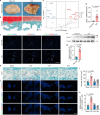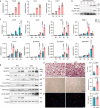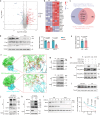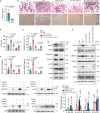A RANKL-UCHL1-sCD13 negative feedback loop limits osteoclastogenesis in subchondral bone to prevent osteoarthritis progression
- PMID: 39389988
- PMCID: PMC11466963
- DOI: 10.1038/s41467-024-53119-2
A RANKL-UCHL1-sCD13 negative feedback loop limits osteoclastogenesis in subchondral bone to prevent osteoarthritis progression
Abstract
Abnormal subchondral bone remodeling plays a pivotal role in the progression of osteoarthritis (OA). Here, we analyzed subchondral bone samples from OA patients and observed a significant upregulation of ubiquitin carboxy-terminal hydrolase L1 (UCHL1) specifically in subchondral bone osteoclasts. Notably, we found a strong correlation between UCHL1 expression and osteoclast activity in the subchondral bone during OA progression in both human and murine models. Conditional UCHL1 deletion in osteoclast precursors exacerbated OA progression, while its overexpression, mediated by adeno-associated virus 9, alleviated this process in male mice. Mechanistically, RANKL stimulates UCHL1 expression in osteoclast precursors, subsequently stabilizing CD13, augmenting soluble CD13 (sCD13) release, and triggering an autocrine inhibitory effect on the MAPK pathway, thereby suppressing osteoclast formation. These findings unveil a previously unidentified negative feedback loop, RANKL-UCHL1-sCD13, that modulates osteoclast formation and presents a potential therapeutic target for OA.
© 2024. The Author(s).
Conflict of interest statement
The authors declare no competing interests.
Figures






Similar articles
-
Loss of UCHL1 Leads to Enhanced Mouse Osteoclast Formation.J Cell Physiol. 2025 Apr;240(4):e70032. doi: 10.1002/jcp.70032. J Cell Physiol. 2025. PMID: 40227754
-
Sotrastaurin, a PKC inhibitor, attenuates RANKL-induced bone resorption and attenuates osteochondral pathologies associated with the development of OA.J Cell Mol Med. 2020 Aug;24(15):8452-8465. doi: 10.1111/jcmm.15404. Epub 2020 Jul 11. J Cell Mol Med. 2020. PMID: 32652826 Free PMC article.
-
The deubiquitinase UCHL1 negatively controls osteoclastogenesis by regulating TAZ/NFATC1 signalling.Int J Biol Sci. 2023 Apr 24;19(8):2319-2332. doi: 10.7150/ijbs.82152. eCollection 2023. Int J Biol Sci. 2023. PMID: 37215988 Free PMC article.
-
Pathological progression of osteoarthritis: a perspective on subchondral bone.Front Med. 2024 Apr;18(2):237-257. doi: 10.1007/s11684-024-1061-y. Epub 2024 Apr 15. Front Med. 2024. PMID: 38619691 Review.
-
Subchondral osteoclasts and osteoarthritis: new insights and potential therapeutic avenues.Acta Biochim Biophys Sin (Shanghai). 2024 Apr 25;56(4):499-512. doi: 10.3724/abbs.2024017. Acta Biochim Biophys Sin (Shanghai). 2024. PMID: 38439665 Free PMC article. Review.
Cited by
-
Quantitative computed tomography analysis of bone microarchitecture is associated with rotator cuff healing.J Orthop Surg Res. 2025 Jul 17;20(1):670. doi: 10.1186/s13018-025-06102-6. J Orthop Surg Res. 2025. PMID: 40676668 Free PMC article.
-
MAGI1 attenuates osteoarthritis by regulating osteoclast fusion in subchondral bone through the RhoA-ROCK1 signaling pathway.J Orthop Translat. 2025 Apr 23;52:167-181. doi: 10.1016/j.jot.2025.04.007. eCollection 2025 May. J Orthop Translat. 2025. PMID: 40322041 Free PMC article.
-
Modulating Osteoclast Activity and Immune Responses with Ultra-Low-Dose Silver Nanoparticle-Loaded TiO2 Nanotubes for Osteoporotic Bone Regeneration.J Funct Biomater. 2025 May 4;16(5):162. doi: 10.3390/jfb16050162. J Funct Biomater. 2025. PMID: 40422827 Free PMC article.
-
CCL7 promotes macrophage polarization and synovitis to exacerbate rheumatoid arthritis.iScience. 2025 Mar 7;28(4):112177. doi: 10.1016/j.isci.2025.112177. eCollection 2025 Apr 18. iScience. 2025. PMID: 40224025 Free PMC article.
-
Intermittent fasting in osteoarthritis: from mechanistic insights to therapeutic potential.Front Nutr. 2025 Jul 21;12:1604872. doi: 10.3389/fnut.2025.1604872. eCollection 2025. Front Nutr. 2025. PMID: 40761349 Free PMC article. Review.
References
-
- Hunter, D. J. & Bierma-Zeinstra, S. Osteoarthritis. The Lancet393, 1745–1759 (2019). - PubMed
-
- Disease, G. B. D., Injury, I. & Prevalence, C. Global, regional, and national incidence, prevalence, and years lived with disability for 354 diseases and injuries for 195 countries and territories, 1990-2017: a systematic analysis for the Global Burden of Disease Study 2017. Lancet392, 1789–1858 (2018). - PMC - PubMed
-
- Latourte, A., Kloppenburg, M. & Richette, P. Emerging pharmaceutical therapies for osteoarthritis. Nature reviews. Rheumatology16, 673–688 (2020). - PubMed
Publication types
MeSH terms
Substances
Grants and funding
LinkOut - more resources
Full Text Sources
Medical
Miscellaneous

